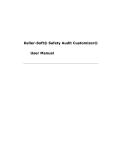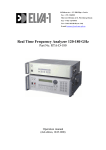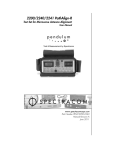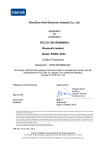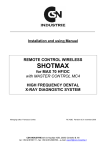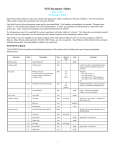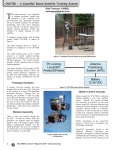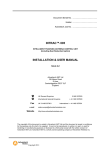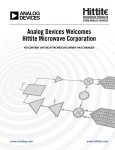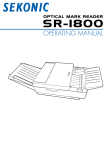Download Millimeter Wave Test Procedures
Transcript
PROCEDURE FROM TCB COUNCIL MEMBERS – ACCEPTED BY FCC LAB MILLIMETER WAVE TEST PROCEDURES Measurement Instrumentation: Spectrum Analyzer External Harmonic Mixer Set, covering the necessary frequency range High Frequency Standard Gain Horn Set, covering the necessary frequency range Diplexer for analyzer, if required External L.O. Amplifier, if required Variable Voltage Supply Optional: Non-conductive antenna adjustment structure (mast) Optional: High-pass and Band pass filters Note: the calibration of equipment operating at the frequencies under investigation may prove to be problematic. Routine calibration of the equipment at lower frequencies may be considered sufficient by the relevant regulatory bodies (e.g., the FCC). These regulatory bodies, as well as the measurement equipment manufacturers and calibration labs, should be consulted with respect to this topic. General Information: I. A radiated method of measurements in order to demonstrate compliance with the various regulatory requirements has been chosen in consideration of test equipment availability, the limitations of many external harmonic mixers, and certain regulatory requirements. A conducted method of measurement could be employed for certain tests if EUT and mixer waveguides both are accessible and of the same type (WG number) and if waveguide sections and transitions can be found. Another potential problem is that the peak power output of devices operating under Sections 15.253 and 15.255 may exceed the +20 dBm input power limit of many commercially available mixers. For these reasons a radiated method is preferred. II. Extreme caution shall be used when measuring the field strength of emissions from mm-wave devices. The beamwidths are extremely narrow; thus very small adjustments to the position of the test antennas are required in order to ensure that the measuring instrumentation is within the maximum beam of the transmitted signal. As a result, it is recommended that handheld field strength measurements be made (i.e., the test antenna (horn) is held in the 1 PROCEDURE FROM TCB COUNCIL MEMBERS – ACCEPTED BY FCC LAB hand). Caution shall be taken to reduce the possibility of the hand, or body, affecting the measurement. Because horn antennas, with large front-to-back ratios, will be used, holding them well behind the flange will greatly reduce the possibility of adversely affecting the measurements. When care is taken, measurements made with this procedure have been shown to be both accurate and repeatable. Caution shall also be taken to reduce the possible overloading of the measuring instrumentation - it may be desirable to make use of high pass and/or band pass filters for certain measurements. III. In order to properly measure either the peak output power or peak power density, the Resolution Bandwidth (RBW) of the measuring instrumentation should be greater than the Emission Bandwidth (EBW)(see definition below) of the signal under investigation. If the EUT is capable of disabling the modulation, such that it transmits an unmodulated carrier, then measurements for peak output power and peak power density should be made in this mode. This is the preferred method. However, if the modulation cannot be disabled, then measurements must be made on the modulated signal. Since Spectrum Analyzers do not typically have RBW’s of sufficient width to encompass the EBW, this method of measurement involves either measuring sections of the emission and totaling those sections, or measuring the peak of the emission with a readily available RBW setting (e.g., 1 MHz) and then mathematically calculating the total peak level over the entire emission bandwidth by adding a correction factor derived from 10log(EBW/RBW). Measurements must be made during the transmit interval. Note: because the FCC currently has reservations about the former method, due to potentially wide variances in results based on instrument settings, the latter method should be employed until the issue is resolved. This correction tends to overestimate the actual peak levels, and thus is considered acceptable by the FCC at this time. The emission bandwidth (EBW) is defined as the width of the signal between two points, one below the carrier center frequency and one above the carrier center frequency, outside of which all emissions are attenuated at least 26 dB below the maximum level of the modulated carrier (from 47 C.F.R. Section 15.403(c)). IV. The peak output power of the EUT may be calculated from the measured peak field strength, if the gain of the EUT’s radiating element is known, using the following equation: 2 PROCEDURE FROM TCB COUNCIL MEMBERS – ACCEPTED BY FCC LAB P = (E × d)2 30G where P is the E is the d is the meters G is the power, in Watts measured peak field strength, in Volts/meter distance at which the measurement was made, in numeric gain of the radiating element If the gain of the radiating element is not known, then either the Effective Radiated Power (ERP) or the Effective Isotropic Radiated Power (EIRP) may be calculated from the measured peak field strength, by using either G = 1.64 or G = 1, respectively, in the above equation. V. The peak power density of an emission may be calculated from its measured peak field strength using the following equation: Pd = P t (4πd2) where Pd is the power density, in Watt/Meters2 Pt is the EIRP, in Watts d is the measurement distance, in meters Conversely, the power density limits specified in the FCC Rules may be converted mathematically to equivalent field strength values, against which the measured field strength of the EUT’s emissions may be directly compared, using the following equation: Pd = E2 377 where Pd is the power density limit at a specific distance, in Watt/Meters2 E is the equivalent field strength at that specific distance, in Volts/meter 377 is free space impedance, in Ohms Solving for the equivalent field strength limit: E = (377 × Pd)½ VI. The average output power levels and the average power density levels may be mathematically derived from the measured peak levels, 3 PROCEDURE FROM TCB COUNCIL MEMBERS – ACCEPTED BY FCC LAB in the case of a pulsed emission, based on the application of a duty cycle correction factor, derived from: 20log(ton/T) where ton is the total “on” time during a transmission burst, in seconds T is the period between transmission bursts, in seconds If the emission under investigation is not pulsed, then the average levels may be measured by using a video filtering technique (i.e., VBW << RBW). VII. Care should be taken to ensure that measurements are made, whenever possible, in the far field, so that a linear distance attenuation factor (20 dB/decade) may be applied. At the frequencies under investigation, the distance from the radiating element of the EUT to the edge of the far field may be calculated from the following equation: r = 2 × ℓ2 λ where r is the distance from the radiating element of the EUT to the edge of the far field, in meters ℓ is the largest dimension of both the radiating element and the test antenna (horn), in meters λ is the wavelength of the emission under investigation (300/f(MHz)), in meters If measurement practicalities or system sensitivity limitations require that the measurement be made in the near field, then an inverse squared distance attenuation factor (40 dB/decade) shall be applied from the point of measurement to the distance calculated as the edge of the far field (if it is less than the distance at which the specific limit (to which compliance is being tested) is specified), after which a linear distance attenuation factor shall be applied out to the distance at which the specific limit (to which compliance is being tested) is specified (e.g., 3 meters). VIII. An external mixer may generate false images. Care should be taken to ensure that any emission measured by the Spectrum Analyzer does indeed originate in the EUT. Most Spectrum Analyzers have a Signal Identification feature that should be utilized if there is 4 PROCEDURE FROM TCB COUNCIL MEMBERS – ACCEPTED BY FCC LAB any question as to the source of the emission under investigation (i.e., it is not the fundamental emission, or a harmonic falling precisely at the correct frequency). In addition, if the fundamental emission overloads the front end of the Spectrum Analyzer, it is likely to result in harmonic distortion. In such a case, a band pass or high pass filter should be used to prevent the measurement of false harmonic levels. 5 PROCEDURE FROM TCB COUNCIL MEMBERS – ACCEPTED BY FCC LAB General Emission Bandwidth Measurement Procedures Test Set-Up Figure 1 Arrange the EUT and test equipment as shown in Figure 1. I. Use the following Spectrum Analyzer settings: Span = approximately 2 to 3 times the EBW, centered on the carrier frequency RBW ≈ 1% of the EBW (if possible - if the EBW is greater than 100 times the largest available RBW, then use that setting) VBW ≥ RBW Sweep = auto Detector function = peak Trace = max hold II. The EUT should be transmitting at its maximum data rate. Allow the trace to stabilize. 6 PROCEDURE FROM TCB COUNCIL MEMBERS – ACCEPTED BY FCC LAB III. Use the marker-to-peak function to set the marker to the peak of the emission. Use the marker-delta function to measure 26 dB down one side of the emission. IV. Reset the marker-delta function, and move the marker to the other side of the emission, until it is (as close as possible to) even with the reference marker level. The marker-delta reading at this point is the 26 dB bandwidth of the emission. V. If this value varies with different modes of operation (e.g., data rate, modulation format, etc.), repeat this test for each variation. General Field Strength Measurement Procedures Arrange the EUT and test equipment as shown in Figure 1. The distance at which various limits are specified in the FCC Rules is 3 meters, however, it is strongly recommended that closer measurement distances be utilized, as permitted by Section 15.31(f)(1) (see General Information VII, above). I. Set Spectrum Analyzer RBW, VBW, span, etc., to the proper values. Note these values. Enable 2 traces, one set to “clear write”, the second set to “max hold”. II. Begin handheld measurements with the test antenna (horn) at a distance of 1 meter from the EUT (see General Information VII, above), in a horizontally polarized position. Slowly adjust its position, entirely covering the plane 1 meter from the EUT. Observation of the 2 active traces on the Spectrum Analyzer will allow refined horn positioning at the point(s) of maximum field intensity. III. Repeat (II) with the horn in a vertically polarized position. IV. If the emission cannot be detected at 1 meter, reduce the RBW in order to increase system sensitivity. Note the value. If the emission still cannot be detected, move the horn closer to the EUT, noting the distance at which a measurement is made. V. Note the maximum level indicated on the Spectrum Analyzer. Adjust this level, if necessary, by the conversion loss of the external mixer used, at the frequency under investigation (cable loss should also be measured, but will probably prove to be negligible, as the external mixer has mixed down the signal to a (relatively) low frequency before it is conducted down the cable to the Spectrum 7 PROCEDURE FROM TCB COUNCIL MEMBERS – ACCEPTED BY FCC LAB Analyzer). Calculate the field strength of the emission at the measurement distance from the following equation (FCC OST 40): E = 2π λ where (120 P/G) ½ E is the field strength of the emission at the measurement distance, in Volts/meter P is the maximum, adjusted level indicated on the Spectrum Analyzer, in Watts λ is the wavelength of the emission under investigation (300/f(MHz)), in meters G is the numeric gain of the test antenna (horn) VI. Based on the distance at which the measurement was made and the calculated distance to the edge of the far field, determine the appropriate distance attenuation factor (see General Information VII, above). Apply this factor to the calculated field strength in order to determine the equivalent field strength at the distance at which the regulatory limit is specified. Based on the RBW used to make the measurement, the measured EBW of the emission under investigation, and the gain of the transmitting element, calculate the power density and peak output power of the emission/EUT (see General Information III and IV, above), and, possibly, the average power density and average output power (see General Information VI, above). Compare to the appropriate limit(s)(see General Information V, above). If it is a pulsed emission, apply the calculated duty cycle correction factor to these levels to determine the average power density and average output power (see General Information VI, above). VII. Repeat (I) - (V) for every emission that must be measured, up through the required frequency range of investigation (as specified by the regulatory requirements to which compliance is being tested), in all operating configurations of which the EUT is capable (e.g., forward-looking vehicle radar systems at rest and in motion (Sections 15.253(b) and (c))). 8 PROCEDURE FROM TCB COUNCIL MEMBERS – ACCEPTED BY FCC LAB General Frequency Stability Measurement Procedures Test Set-Up temperature chamber 10 - 100 cm mixer w/horn EUT LO pre-amp diplexer variable voltage supply spectrum analyzer V FIGURE 2 I. Arrange EUT and test equipment as shown in Figure 2. The external mixer may be placed inside the temperature chamber only if its frequency drift characteristics v temperature are known and can be factored in, otherwise, the mixer should be placed outside the chamber in front of the temperature chamber door, and the chamber door opened for each reading. II. With the EUT at ambient temperature (approximately 25 °C) and voltage source set to the EUT’s nominal operating voltage (100%), record the spectrum mask of the EUT emission on the Spectrum Analyzer. III. Vary EUT power supply between 85% - 115% of nominal, and record the frequency excursion of the EUT emission mask. IV. Set the power supply to 100% nominal setting, raise EUT operating temperature to 50 °C. Record the frequency excursion of the EUT emission mask. V. Repeat step 4 above at each 10 °C step down to -20 °C. 9 PROCEDURE FROM TCB COUNCIL MEMBERS – ACCEPTED BY FCC LAB The EUT frequency excursion must remain within the frequency ranges called out in the appropriate regulatory standards. Note: The test distance is chosen to insure that input to the mixer is less than the rated maximum, using the relationship between transmit power, received power, transmit antenna gain, receive antenna gain, and path loss: Pr, dBm = Pt, dBm +Gt, dBi + Gr, dBi – Lp, dB where Lp = -27.6dB *** Included below, for reference, are checksheets provided by the FCC during TCB training classes intended for use during the review of mmWave devices seeking authorization under Sections 15.253 or 15.255. Vehicle Radar Systems (47 C.F.R. Section 15.253) _ Because mm wave devices are not categorically excluded from RF exposure requirements, they will not be designated under this scope of accreditation at this time. 15.253(a): ___ Does the EUT meet the definition of a vehicle-mounted field disturbance sensor, as its primary mode of operation, based on the technical description? 15.253(b): ___ Were acceptable test procedures and instrument settings used to measure the radiated power density of the fundamental emission? 10 PROCEDURE FROM TCB COUNCIL MEMBERS – ACCEPTED BY FCC LAB ___ Does the measured power density comply with the appropriate limit, as determined by the frequency band of operation, the position of the EUT with respect to the vehicle, and whether or not the vehicle is in motion? 15.253(c): ___ Do all out-of-band emissions meet the definition of spurious emissions? 15.253(c)(1): ___ Were acceptable test procedures and instrument settings used to measure unwanted radiated emission levels below 1 GHz? ___ Do the measured unwanted radiated emission levels comply with the Section 15.209 field strength limit? 15.253(c)(2): ___ Were acceptable test procedures and instrument settings used to measure the radiated power density of spurious emissions? ___ Was the correct frequency range investigated? ___ Do the measured spurious power densities comply with the appropriate limit, as determined by the frequency band of operation, the frequency of the spurious emission, and the position of the EUT with respect to the vehicle? 15.253(d): ___ Were acceptable test procedures and instrument settings used to determine the peak levels of the measured radiated power densities of all emissions? ___ Do the peak levels of the measured power densities comply with the limit of Section 15.35(b)? 15.253(e): 11 PROCEDURE FROM TCB COUNCIL MEMBERS – ACCEPTED BY FCC LAB ___ Was an acceptable test procedure was used to measure frequency stability? ___ Does the measured frequency stability data indicate that the fundamental emission will be maintained within the band of operation under all conditions of normal operation, as specified in the user’s manual? 15.203 and 15.204: ___ Does the EUT comply with these Sections? _ Test procedures for mm wave devices are, as of yet, undocumented. When a “recommended” test procedure is released by the OET Lab, or by some industry group, guidance will be provided as to what is considered “acceptable test procedures”. _ Convert power density limits to EIRP levels, then to equivalent field strengths at the measurement distance. Measured field strengths may then be compared to these values. _ Determine whether measurements are made in the far field or not, so that a proper distance correction factor may be applied. _ In re 15.253(d)- a test or a calculation may be used to determine the peak level of the emission, as determined by the emission characteristics. _ In re 15.253(e)- a plot of the emission at the bandedge, with the EUT tuned to a bandedge channel, may be required for devices that do not utilize a standard carrier which may be measured. mm-Wave Systems - Section 15.255 _ Because mm wave devices are not categorically excluded from RF exposure requirements, they will not be designated under this scope of accreditation at this time. 12 PROCEDURE FROM TCB COUNCIL MEMBERS – ACCEPTED BY FCC LAB 15.255(a): ___ Does the EUT operate in a manner which is not excluded by this Section, based on the technical description, user’s manual, or any advertising literature which has been submitted? 15.255(b)(1) and (2): ___ Were acceptable test procedures and instrument settings used to measure the peak radiated power density and the occupied bandwidth of the fundamental emission? ___ Were acceptable methods used to calculate the average radiated power density of the fundamental emission? ___ Does the measured peak power density comply with the appropriate limit, as determined by the type of operation, the occupied bandwidth, and the frequency of the emission? ___ Does the calculated average power density comply with the appropriate limit, as determined by the type of operation, the occupied bandwidth, and the frequency of the emission? 15.255(b)(3): ___ Were acceptable test procedures and instrument settings used to measure the peak output power and the peak radiated power density of the fundamental emission? ___ Do the measured peak output power and peak radiated power density comply with the appropriate limit? 15.255(c)(1): ___ Do all out-of-band emissions meet the definition of spurious emissions? 15.255(c)(2): 13 PROCEDURE FROM TCB COUNCIL MEMBERS – ACCEPTED BY FCC LAB ___ Were acceptable test procedures and instrument settings used to measure unwanted radiated emission levels below 1 GHz? ___ Do the measured unwanted radiated emission levels comply with the Section 15.209 field strength limit? 15.255(c)(3): ___ Were acceptable test procedures and instrument settings used to measure the radiated power density of spurious emissions? ___ Was the correct frequency range investigated? ___ Do the measured spurious power densities comply with the 90 pW/cm2 limit? 15.255(c)(4): ___ Does the EUT comply with Section 15.215(b)? 15.253(d): ___ Are all emissions in the 59.0-59.05 GHz band either spurious, or related to a publicly accessible coordination channel? 15.253(e): ___ Were acceptable test procedures and instrument settings used to measure the peak output power and emission bandwidth? ___ Does the measured peak output power comply with the appropriate limit, as determined by the emission bandwidth? 15.255(f): ___ Was an acceptable test procedure was used to measure frequency stability? ___ Does the measured frequency stability data indicate that the fundamental emission will be maintained within the band of operation 14 PROCEDURE FROM TCB COUNCIL MEMBERS – ACCEPTED BY FCC LAB under all conditions of normal operation, as specified in the user’s manual? 15.255(h): ___ Does the applicant state that the EUT will not be equipped with external phase-locking inputs that permit beam-forming arrays to be realized? 15.255(i): ___ If applicable, does the applicant state that the EUT transmits the required identification feature? ___ Does the required identification feature contain all of the necessary information? ___ Is a method specified whereby interested parties can obtain sufficient information, at no cost, to enable them to fully detect and decode this transmitter identification information? 15.203, 15.204, and 15.207: ___ Does the EUT comply with these Sections? _ Test procedures for mm wave devices are, as of yet, undocumented. When a “recommended” test procedure is released by the OET Lab, or by some industry group, guidance will be provided as to what is considered “acceptable test procedures”. _ Convert power density limits to EIRP levels, then to equivalent field strengths at the measurement distance. Measured field strengths may then be compared to these values. _ Determine whether measurements are made in the far field or not, so that a proper distance correction factor may be applied. _ In re 15.255(f)- a plot of the emission at the bandedge, with 15 PROCEDURE FROM TCB COUNCIL MEMBERS – ACCEPTED BY FCC LAB the EUT tuned to a bandedge channel, may be required for devices that do not utilize a standard carrier which may be measured. 16


















